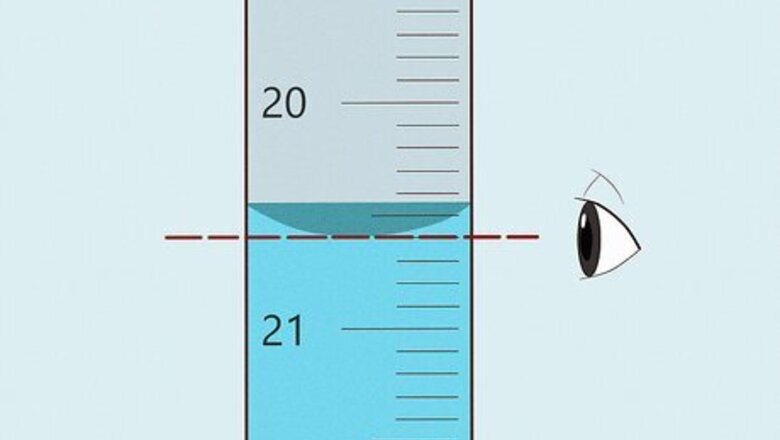
views
Reading a Burette
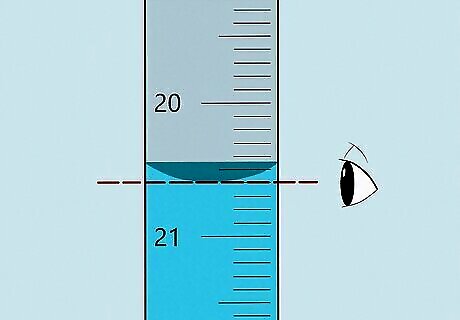
Take your reading from the bottom of the liquid’s meniscus. Notice how the surface of the liquid in your burette isn’t a flat line. Instead, it dips in the middle to form a shallow “U” shape, or a “meniscus.” When you read a burette, imagine a line that connects the bottom of this U horizontally to the buret’s measurement marks (or “graduations”), and take that as your reading. Ensure your eye is level with the bottom of the meniscus. If you read the burette from above or below the surface of the liquid inside, you’ll get an inaccurate reading. If it helps, use a ruler to draw a straight line on a white index card, then hold this card behind the burette as you read it. Line up the line with the bottom of the meniscus to clearly indicate its position.
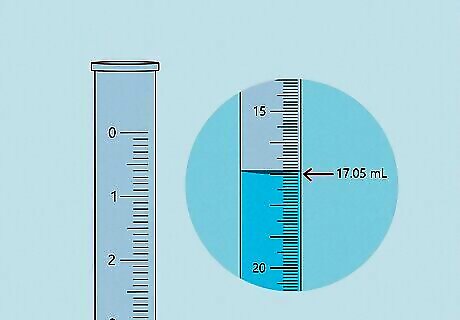
Count the burette’s markings from the top down. Most burettes start with the “0” measurement at the very top, and the maximum measurement at the bottom. So when you read a burette, find the nearest marked measurement above the liquid, then count the increments down to the level of the meniscus, rather than counting upward. For example, if the liquid in your burette rests with the 15 mL mark above it and the 20 mL mark below it, the reading is something like 17.05 mL, not 20 mL or more. This is because a burette measures how much liquid you dispense out of it, not how much liquid is currently in the buret. In fact, a full burette will read “0.00.” Most burettes give markings to the nearest 0.10 mL, but the most accurate measurements are to the nearest 0.05 mL.
Using a Burette
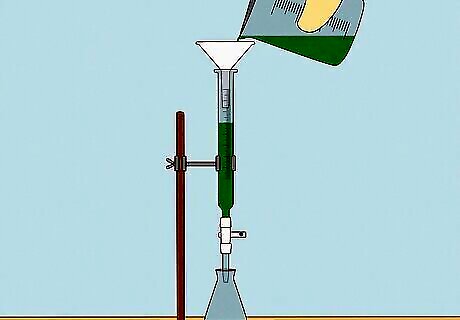
Mount and fill the burette with your liquid. In titration experiments, this liquid is the titrant, which you’ll be adding to the beaker. Place your clean burette on its stand and fill it with as much titrant as the experiment requires. To do this, use a clean funnel, or a squeeze bottle filled with the titrant. Note that not every experiment requires a full burette. In fact, most will not.
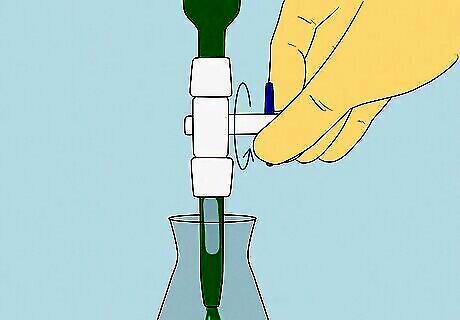
Remove any air bubbles in the tip by opening the stopcock. Most burettes operate via a stopcock at the bottom that opens and closes to allow the titrant to flow. Slowly and carefully open the stopcock, turning the handle counterclockwise, until fluid flows through the tip into a waste container, removing any air bubbles. Close the stopcock by turning it the opposite direction, until the handle is perpendicular to the burette.
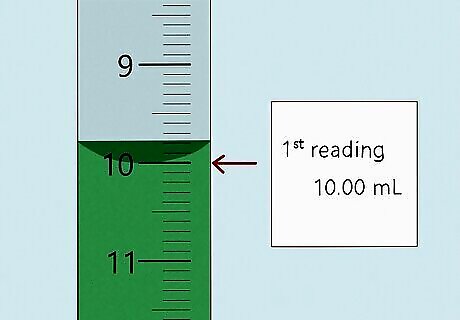
Take an initial reading of the burette. Using the methods above, take and record an initial reading of the liquid in your burette to the nearest 0.05 mL, and record this reading on a sheet of paper.
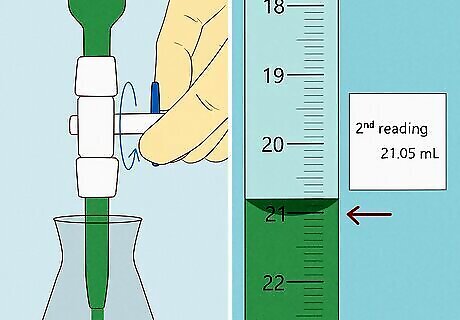
Dispense the titrant, and take a second reading. Use the stopcock to dispense titrant into the beaker below according to the instructions of your experiment. Afterward, wait 30-60 seconds for the liquid to settle, then take a second reading to the nearest 0.05 mL.
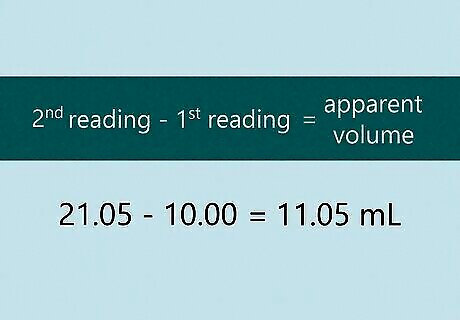
Subtract your initial reading from your second to find apparent volume. Subtract the first reading from the second reading to find how much liquid was dispensed. This is known as the apparent volume, or “titer” in titration experiments. For example, if your first reading was 10.00 mL, and your second reading was 21.05 mL, then the amount of liquid dispensed is 21.05 - 10.00, which is 11.05 mL.
Taking the Most Accurate Reading
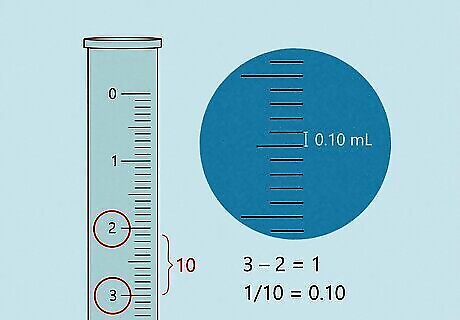
Familiarize yourself with the scale increment of the burette. Before you take a reading, examine the measurement markings on the burette. Some are labeled, but the smaller increments are not. To find how much volume the smaller markings measure, subtract 2 adjacent numbered markings, then divide the answer by how many smaller markings are between them. For example, if a burette is numbered “0, 1, 2, 3…” with 10 markings between each number, then 3 - 2 = 1, and 1 / 10 = 0.10, so each small marking measures 0.10 mL of liquid. Also, most burettes measure in milliliters, but not all. Consult the “0” at the top, which should be labeled with the burette’s measurement system.
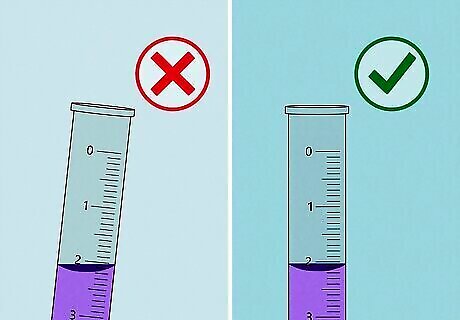
Ensure the burette is level and stable. Make sure your burette is clamped securely into its stand, and that it stands as upright as possible for the most accurate reading. Let the liquid settle for 10-20 seconds after moving the buret, to make sure all the liquid has settled at the bottom and isn’t clinging to the sides.
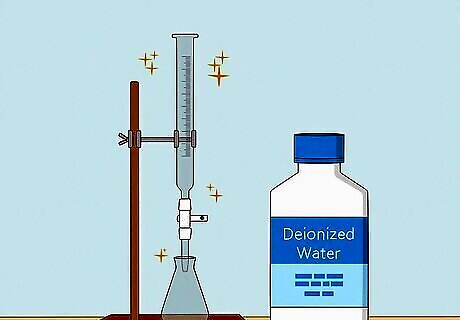
Clean the burette thoroughly before and after each use. To clean a burette, rinse it 3 times with deionized water to flush out any contaminants. As you do, hold and roll the burette horizontally to ensure the inside is entirely rinsed. Then, place the burette back onto its stand and open the stopcock. Let the deionized water rinse into a waste container for 1-2 minutes before using the burette. Also disassemble the stopcock, or any other pouring mechanism, and rinse it 3 times with deionized water. Never use a bristled brush on a burette, which may scratch the glass.
Calibrating a Burette
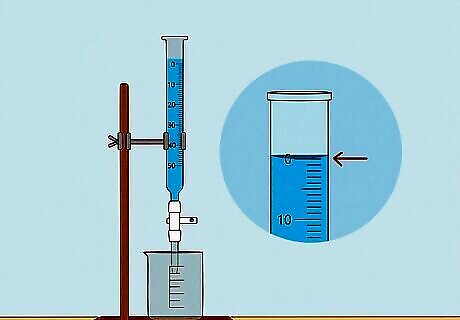
Fill the burette to the top, then drain it to the 0.00 mark. Fill your burette with distilled water up to or just below its rim. Then, mount it on its stand and carefully open the stopcock to drain the water so that the meniscus reads “0.00.” Close the stopcock, then gently touch the burette’s spout to the side of the beaker beneath it to dispense any clinging drops. Also, take a temperature reading of the water with a thermometer, which will come in handy in the next steps.
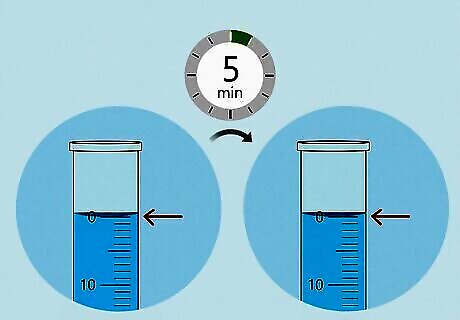
Wait 5 minutes, then ensure the burette still reads 0.00. If the water has dropped below that mark in those 5 minutes, tighten the stopcock and repeat the first step. If it’s still draining during the 5 minutes, you may have either a faulty stopcock or burette. Replace both and repeat the first step to ensure the stopcock and burette are functioning.
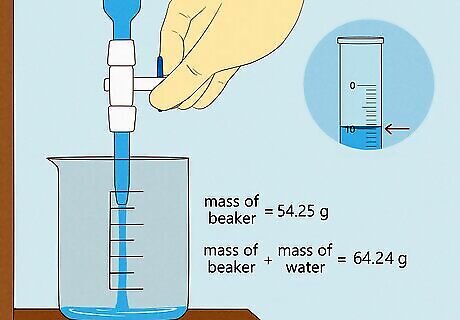
Drain 10mL of water into a 100mL beaker, then weigh it. Weigh the beaker first and note its initial mass to the nearest 1 mg. Then drain 10mL of water from the burette into the beaker, touching the burette’s tip to the beaker’s walls and waiting 30 seconds for water in the burette to drip down to the meniscus. Take a second reading to the nearest 0.05 mL, then weigh and record the mass of the beaker again.
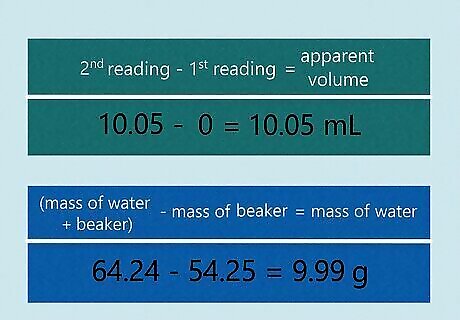
Find the apparent volume and mass of the water. Subtract your first burette reading from the second to find your apparent volume. Then subtract your first weight reading of your beaker from the second reading to find the mass of water in the beaker that corresponds to this apparent volume reading.
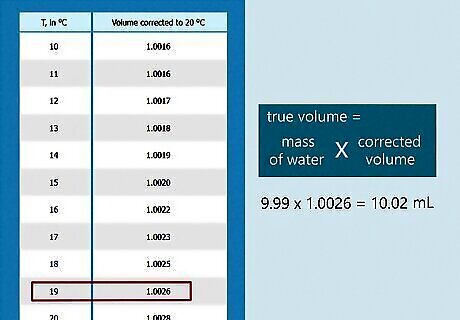
Convert the mass at-temperature into true volume. Water’s volume changes with the temperature, so use an online true volume chart to convert the apparent volume you found into true volume. To do this, find the temperature of your water on the chart, then multiply the mass of water in the beaker by the corresponding corrected volume on the chart.
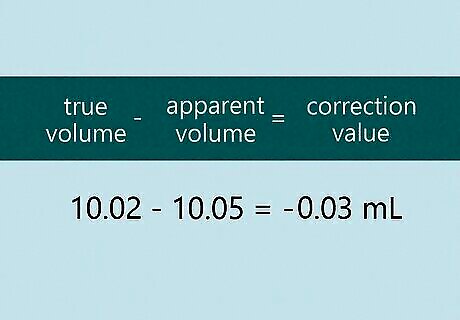
Subtract the apparent volume from the true volume to find your correction value. The true volume is the value you found by multiplying your data by the corrected volume on the chart. Subtract the apparent volume from its corresponding true volume value to find your correction value. This correction value may be either positive or negative.
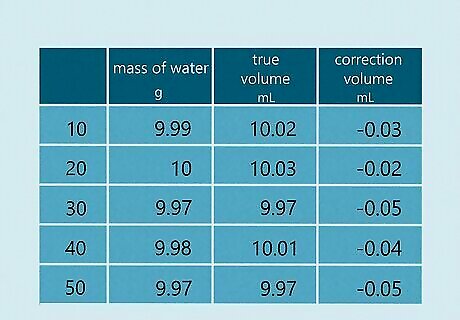
Repeat the calibration to confirm your correction value. Drain the burette down to 20mL, take a reading, then weigh the beaker, and find the correction value for this new set of data. Do the same for the 30 mL mark, 40, 50, and so on, until all the liquid is drained, weighing and recording the new mass of the beaker after every interval, and finding the corresponding correction value. For a Class A burette, the correction value shouldn’t exceed ±0.05 mL. If it does, the burette may be faulty and unreliable. For the most accurate calibration, repeat the entire process up to this point 2 more times.
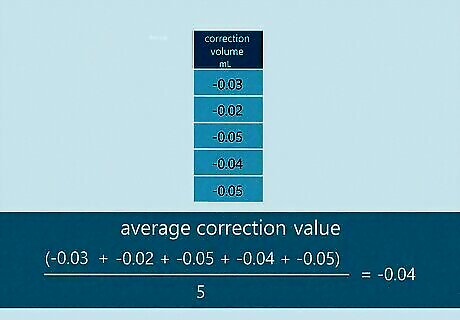
Find the average correction value and use it in your experiment. Add every correction value found during your calibration, then divide it by the number of correction values to find the average correction value. For example, if your average correction value is -0.02 mL, then you’ll subtract 0.02 mL from every apparent volume reading in your experiment to find the true volume of water you dispensed.

















Comments
0 comment